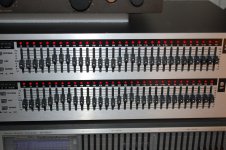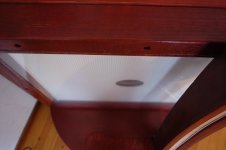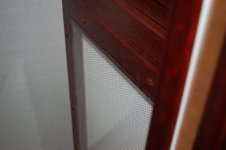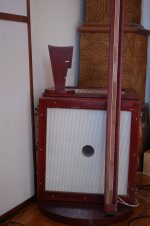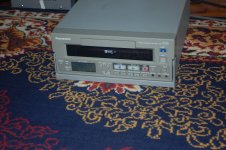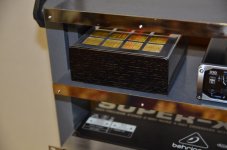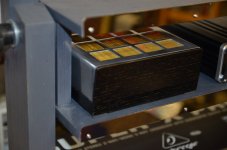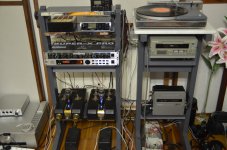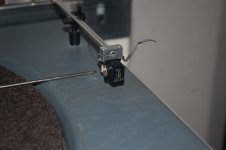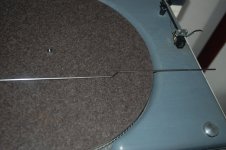In addition, I want to write that I tried to acoustically design subwoofers using boxes, but I didn’t get anything special except for the color of the box.
Therefore, I used only one element, this is a top cover with a specific "membrane".
This cover cuts off the half-ceiling connection behind the subwoofer and this plays a rather large role in suppressing parasitic resonances in the wide range of 120-500Hz.
I used a tone generator to "aurally" identify peaks and dips in the frequency range associated with room acoustics, there are some nuances, but more on that later.
I have a strong desire to make the frequency of 30-500Hz the most even. Everything that is higher in the range suits me completely.
Therefore, I used only one element, this is a top cover with a specific "membrane".
This cover cuts off the half-ceiling connection behind the subwoofer and this plays a rather large role in suppressing parasitic resonances in the wide range of 120-500Hz.
I used a tone generator to "aurally" identify peaks and dips in the frequency range associated with room acoustics, there are some nuances, but more on that later.
I have a strong desire to make the frequency of 30-500Hz the most even. Everything that is higher in the range suits me completely.
For acoustic measurements i use the Neutrik Audiotracer 3201 as it has a warble function to eliminate standing waves during measurements.
https://www.radiomuseum.org/r/neutrik_schallpegelmessgeraetaudiotracer_3201.html
https://www.radiomuseum.org/r/neutrik_schallpegelmessgeraetaudiotracer_3201.html
Thanks for the recommendation.
I measure the frequency response of the speakers with a microphone and the appropriate computer program, in the near field and from the listening position.
But the microphone is one thing, and the human ear is a little different, so after measuring with a microphone, I send a signal from the tone generator and determine the obvious peaks and dips, this is especially true in the low-frequency region where traditional ups and downs in frequency response are observed in small rooms.
This is how the frequency correction looks like up to 1000 Hz of the work of my electrostatic low-frequency link:
I measure the frequency response of the speakers with a microphone and the appropriate computer program, in the near field and from the listening position.
But the microphone is one thing, and the human ear is a little different, so after measuring with a microphone, I send a signal from the tone generator and determine the obvious peaks and dips, this is especially true in the low-frequency region where traditional ups and downs in frequency response are observed in small rooms.
This is how the frequency correction looks like up to 1000 Hz of the work of my electrostatic low-frequency link:
Attachments
Perhaps I already wrote it, but I glued additional passive membranes on both sides to the subwoofer in order to attach an additional mass of air to the membrane package and thus increase the mass of the movable membrane system, as well as to eliminate a number of parasitic resonances. Well, dust will not get inside the package:
Attachments
Not any kind of test music - cooked sound, end to end. The old original Brubeck a better test. No kidding.
Get some percussion music THAT is what makes ESLs shine. Paul Lansky or Steve Reich's percussion pieces. Or the cowbell I posted a while back (see edit below).
B.
EDIT
https://www.diyaudio.com/community/threads/cowbell.341203/#post-5878278
Get some percussion music THAT is what makes ESLs shine. Paul Lansky or Steve Reich's percussion pieces. Or the cowbell I posted a while back (see edit below).
B.
EDIT
https://www.diyaudio.com/community/threads/cowbell.341203/#post-5878278
Hello. I have Brubeck and I have percussion, I will do it.Not any kind of test music - cooked sound, end to end. The old original Brubeck a better test. No kidding.
Get some percussion music THAT is what makes ESLs shine. Paul Lansky or Steve Reich's percussion pieces. Or the cowbell I posted a while back (see edit below).
B.
EDIT
https://www.diyaudio.com/community/threads/cowbell.341203/#post-5878278
Vibraphone with drum set:
https://drive.google.com/file/d/1gH3028KGQVKjhNwPqse0FJRC_wVjEMxn/view?usp=sharing
https://drive.google.com/file/d/1gH3028KGQVKjhNwPqse0FJRC_wVjEMxn/view?usp=sharing
Hello friends.
Recorded a few percussionists.
Played on a Panasonic 5700 VCR.
As we all know, the video tape recorder has excellent technical characteristics, and this is a frequency range of 20-20000 Hz, a dynamic range of 90 dB. And all this is analog recording and playback.
In this case, a digital record.
But on this tape recorder I record the vinyl analogue of my friends, those records that I don’t have, but I don’t have much 🙂.
https://drive.google.com/file/d/1jwzTmg1vHh2b3-gj1pdoCmrBC0sQbhaw/view?usp=sharing
Recorded a few percussionists.
Played on a Panasonic 5700 VCR.
As we all know, the video tape recorder has excellent technical characteristics, and this is a frequency range of 20-20000 Hz, a dynamic range of 90 dB. And all this is analog recording and playback.
In this case, a digital record.
But on this tape recorder I record the vinyl analogue of my friends, those records that I don’t have, but I don’t have much 🙂.
https://drive.google.com/file/d/1jwzTmg1vHh2b3-gj1pdoCmrBC0sQbhaw/view?usp=sharing
Attachments
Hi friends.
I decided to make a house for a pair of class D amplifiers from ash and aluminum.
They are assembled on a 3255 chip.
They drive the bass bar and treble bar with ease. They are battery powered by a 36V mid-point LG Li-Ion battery.
The capacity of 48Ah is enough to discharge the battery from 38V to 34V for half a month of everyday listening to music. I am delighted.
I also use professional tools in the audio path, this is an active crossover and a parametric equalizer, I preferred this equalizer to a graphic equalizer because it can remove parasitic resonance at virtually any frequency, but I needed just that.
The preamplifier and vinyl equalizer are tube custom-made.
Band separation was most effective at 600 Hz.
Let it be for now.
I decided to make a house for a pair of class D amplifiers from ash and aluminum.
They are assembled on a 3255 chip.
They drive the bass bar and treble bar with ease. They are battery powered by a 36V mid-point LG Li-Ion battery.
The capacity of 48Ah is enough to discharge the battery from 38V to 34V for half a month of everyday listening to music. I am delighted.
I also use professional tools in the audio path, this is an active crossover and a parametric equalizer, I preferred this equalizer to a graphic equalizer because it can remove parasitic resonance at virtually any frequency, but I needed just that.
The preamplifier and vinyl equalizer are tube custom-made.
Band separation was most effective at 600 Hz.
Let it be for now.
Attachments
Last edited:
Yes, of course, I have step-up transformers, for a toroid bass driver with a transformation ratio of 1:200, and a high-frequency 1:100.
- Home
- Loudspeakers
- Planars & Exotics
- Full-range, two-way ESL
